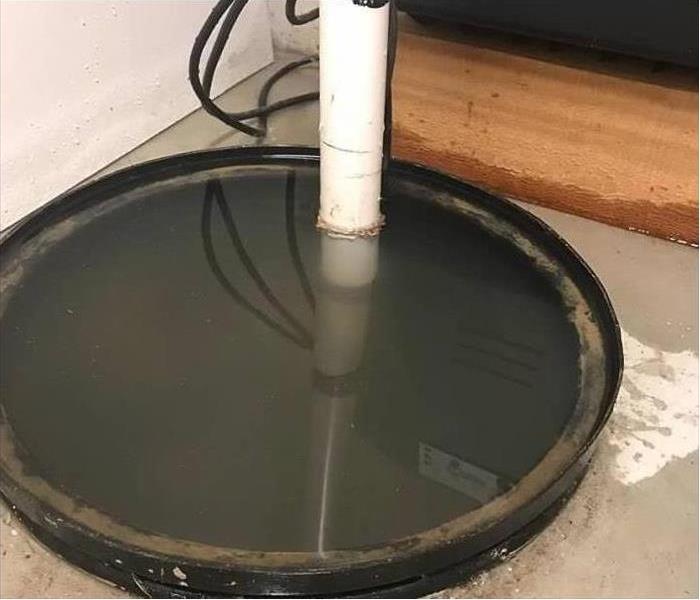Here are some Common Reasons for Sump Pump Failure
7/13/2021 (Permalink)
 Should you experience water damage from a sump pump failure, call SERVPRO of Dane County West #608-497-3331
Should you experience water damage from a sump pump failure, call SERVPRO of Dane County West #608-497-3331
Sump Pump Failures - Power Outage from Storms Most Common Failure
The American Society of Home Inspectors did a study that showed more than 60% of American homes suffer from underground wetness or water damage, and there’s a likelihood that an even larger percentage will deal with a flooded basement at some point. It doesn’t always take a large amount of water to create a large amount of damage. It takes very little standing water and relatively little time for mold and mildew to take over and create problems if not treated properly.
At SERVPRO of Dane County West, a significant percentage of water damage in basements is caused by sump pump failures. The popularity of sump pumps has grown exponentially in the past couple of decades, largely in part to a legal amendment to the US Federal Clean Water Act in 1987 that requires certain homes to have a sump pump, even if they are not necessarily high-risk for floods.
Here are some common reasons for Sump Pump Failure:
1. Power Failure - The most common cause of sump pump failure is an electrical power outage. To prevent this, have a backup generator that can be manually activated. If your primary pump mechanically fails, though, a generator cannot help in this situation. But in the event of a storm where the power is knocked out for any length of time, a backup generator can be a lifesaver.
2. The Sump Pump is the Wrong Size - If you have an incorrectly sized pump or are not installed properly, there will most likely be a problem.
3. Improper Installation - Installing a sump pump must be done exactly right. The manufacturer’s instructions must be followed carefully for the installation to avoid severe water damage down the road. Most manufacturers recommend or require a check valve to be installed on the discharge line. If not installed, the back-flow of water can cause the pump impeller to rotate backward and unscrew off the motor shaft. In this scenario, you will still hear the pump motor running, but it would not be pumping any water.
Most manufacturers require drilling a small air relief hole in the discharge line between the pump and the check valve to prevent the pump from overcoming the air pressure in the discharge pipe. The discharge pipe must be of the required diameter.
Lastly, the sump pump pit should not be set in dirt or gravel. This causes debris to enter your pump and interfere with the on/off switch or float arm.
4. Switch Problems - The leading mechanical cause of sump pump problems is a switch problem. This occurs when the pump shifts from its position inside the basin, rendering the float ineffective. Float is responsible for the smooth operation of the on/off switch. Your sump pump relies on both the switch and the float arm mechanisms to operate effectively.
5. Lack of Maintenance - Some pump manufacturers recommend the pump to be run every 2-3 months. Some recommend a yearly program completed just before the rainy season hits.
Here are some additional manufacturer recommendations:
- If there is a backup pump, unplug the primary pump and run the backup pump to make sure it works properly
- When testing your sump pump, go outside to make sure it is discharging water
- Sometimes the pump can run but not pump any water. This means the impeller has disengaged from the pump shaft, or the check valve is installed backward.
- Check the operation of the float to make sure it is not restricted
- Clean out the air hole in the discharge line
- Listen for any unusual noises when the motor is running
- Replace the battery on the backup sump pump every 2 or 3 years
6. Frozen or Clogged Discharge Lines - If water cannot exit your home through the discharge line, your system will not work. Keeping the discharge pipe protected from freezing and free of sticks, dirt, rocks, and other debris is important. Protecting the water’s exit point of the discharge pipe will keep debris and animals out of the system, making it optimal for your sump pump.
The grated covering will not stop the lines from freezing or becoming blocked by ice and snow. A special grated discharge line attachment should help; it is placed near your home on the discharge line. It includes openings that give water a way to flow out of the pipe if the line is blocked further down.
7. Product Defect - Though rare, product defect is always a possibility and does happen. It is wise to test the pump when it is initially installed to ensure it operates properly.
You can avoid many of these issues and give a longer lifespan to the equipment by performing regular maintenance.
Should you experience water damage from a sump pump failure, call SERVPRO of Dane County West #608-497-3331
Source: "7 Causes of Sump Pump Failure and What to Do," Tony Rubeo





 24/7 Emergency Service
24/7 Emergency Service